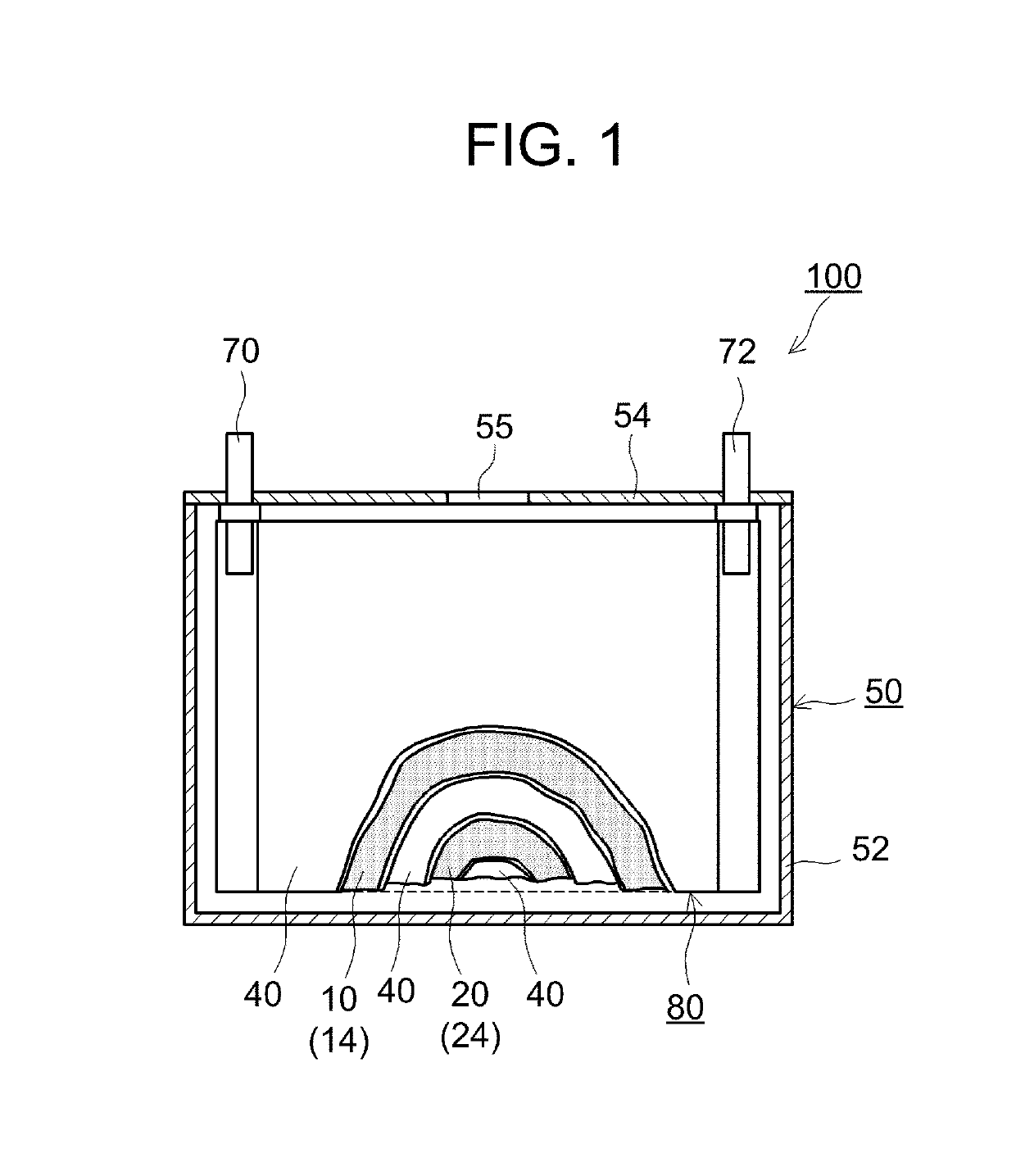Positive electrode material and lithium secondary battery using the same
a lithium secondary battery and positive electrode technology, applied in the direction of positive electrodes, active material electrodes, cell components, etc., can solve the problems of entanglement of li ion into and from the surface of low li ion conductivity of electron-conducting oxide, and the disadvantage of coating the positive electrode active material with electron-conducting oxide, etc., to achieve low initial resistance, less decrease in battery capacity, and good high-rate cycle characteristics
- Summary
- Abstract
- Description
- Claims
- Application Information
AI Technical Summary
Benefits of technology
Problems solved by technology
Method used
Image
Examples
examples 1 to 9
[0058]First, a positive electrode active material identical to that of Comparative Example 1 was prepared. Next, the prepared positive electrode active material, LaNi0.4Co0.3Mn0.3O3 as an electron-conducting oxide, and Li2WO4 as a Li ion-conducting oxide were mixed, and the mixture was heat-treated (co-baked) at 400° C. for 5 hours. The mixing ratio among the positive electrode active material, the electron-conducting oxide, and the Li ion-conducting oxide was controlled so that the amounts of the electron-conducting oxide added and the Li ion-conducting oxide added were each 0.005 to 6 parts by mass per 100 parts by mass of the positive electrode active material. Both the electron-conducting oxide in the form of particles and the Li ion-conducting oxide in the form of particles were thus attached to the surface of the positive electrode active material in the form of particles, and the resulting material was used as a positive electrode material.
[0059]Evaluation of Battery Characte...
examples 13 to 20
[0076]Positive electrode materials were used that were the same as that used in Example 3, except that the type of the positive electrode active material and the type of the electron-conducting oxide were changed as shown in Table 3. The battery characteristics were evaluated in the same manner as in Examination I. The results are shown in Table 3.
TABLE 3Electron-conducting oxideLi ion-conducting oxidePositive electrodeAmountAmountBatteryCycleactive materialaddedaddedresistancecapacityCompositionComposition(parts byComposition(parts by(relativeretentionformulaformulamass)formulamass)value)(%)Example 13LiNi0.5Co0.2Mn0.3O2LaNi0.5Co0.2Mn0.3O30.05Li2WO40.057280Example 14LiNi0.6Co0.2Mn0.2O2LaNi0.6Co0.2Mn0.2O30.05Li2WO40.057576Example 15LiNi0.8Co0.1Mn0.1O2LaNi0.8Co0.1Mn0.1O30.05Li2WO40.057771Example 16LiNi0.8Co0.15Al0.05O2LaNi0.8Co0.2O30.05Li2WO40.057584Example 17LiNi0.9Co0.07Al0.03O2LaNi0.9Co0.1O30.05Li2WO40.057776Example 18LiNi0.9Co0.07Al0.03O2La0.5Ca0.5Ni0.4Co0.3Mn0.3O30.05Li2WO40.0558...
examples 21 to 23
[0078]In Example 21, a composite material was produced that included a positive electrode active material in the form of particles and a film portion formed on the surface of the positive electrode active material, the film portion containing an electron-conducting oxide and a Li ion-conducting oxide. This composite material was used as a positive electrode material. Specifically, first, the electron-conducting oxide was attached in the form of a film to the surface of the positive electrode active material in the form of particles. More specifically, first, a sulfuric acid salt of lanthanum, a sulfuric acid salt of nickel, a sulfuric acid salt of cobalt, and a sulfuric acid salt of manganese were weighed so that the molar ratio among the metal elements, as expressed by La:Ni:Co:Mn, would be 1.0:0.4:0.3:0.3, and an aqueous solution containing these metal elements was prepared. Next, the positive electrode active material in the form of particles was added to the prepared aqueous sol...
PUM
| Property | Measurement | Unit |
|---|---|---|
| particle size | aaaaa | aaaaa |
| particle size | aaaaa | aaaaa |
| particle size | aaaaa | aaaaa |
Abstract
Description
Claims
Application Information
 Login to View More
Login to View More - R&D
- Intellectual Property
- Life Sciences
- Materials
- Tech Scout
- Unparalleled Data Quality
- Higher Quality Content
- 60% Fewer Hallucinations
Browse by: Latest US Patents, China's latest patents, Technical Efficacy Thesaurus, Application Domain, Technology Topic, Popular Technical Reports.
© 2025 PatSnap. All rights reserved.Legal|Privacy policy|Modern Slavery Act Transparency Statement|Sitemap|About US| Contact US: help@patsnap.com


